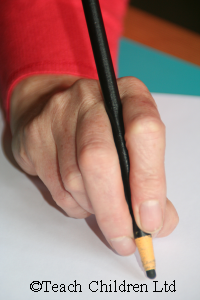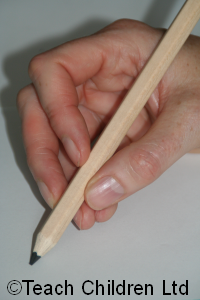
The Adaptive Tripod pencil grip is identical to the Dynamic Tripod grip (still considered the most appropriate for handwriting) in that the pencil is held between the tip of the thumb and index finger and rests on the middle finger. The main difference is that the shaft of the pencil rests in the ‘V between the index and middle finger. This gives an open web space which allows the fingers to move freely so that a fluid handwriting style can be achieved.
This grip is often more appropriate for children who have low muscle tone or hyper mobility of the finger joints. It can also benefit older children who:
- Continue to hold a pencil too tightly
- Hold the pencil lightly using just their fingertips (often writing using whole arm movements)
- Hold a pencil with their thumb wrapped around and across the pencil and index finger.
Changing to the Adaptive Tripod grip is not a quick fix for children who have poor hand and finger strength. These strengths still need to be developed to make handwriting more comfortable.
How to form the Adaptive Tripod Grip for Right & Left-handed Writers
From the research I have done I cannot find any information that the grip needs to be adapted for left handed writers. So, our step by step guide applies to both left and right-handed writers and can be accessed using the following link and scrolling down the page: http://bit.ly/2XpuI8I

